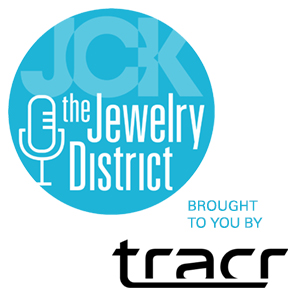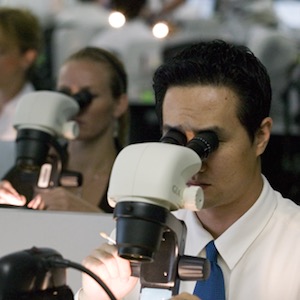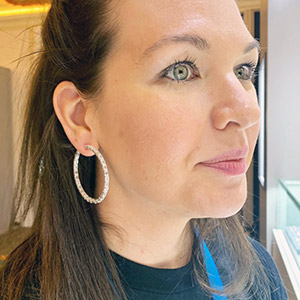
You’ll hear JCK editor-in-chief Victoria Gomelsky and news director Rob Bates reflect on the 2024 JCK show (held May 31–June 3 in Las Vegas), sharing their impressions of the natural and lab-grown diamond sectors’ respective presences, updates from De Beers, their experiences interviewing the president of Botswana, and their thoughts on producer countries participating in the show. Victoria also talks about what she saw and learned during her press trip touring diamond factories in Surat, India, with Ben Bridge Jeweler.
Listen Now
Sponsored by Tracr: tracr.com
Show Notes
02:20 Trading show stories
04:15 Interviewing Botswana president Masisi
08:00 New strategy and other announcements from De Beers
15:30 Victoria’s trip to India
Episode Credits
Hosts: Rob Bates and Victoria Gomelsky
Producer and engineer: Natalie Chomet
Editor: Riley McCaskill
Plugs: @jckmagazine; tracr.com
Show Recap
Trading show stories
Rob saw the bustling crowds on the show floor as a good sign. There was a lot of energy and a roster full of events. The natural diamond industry in particular made a concerted effort to put itself forward at this show. Within one 24-hour period there were four major events where natural diamonds took center stage: the Diamonds Do Good awards dinner, De Beers’ breakfast, Victoria’s fireside chat with Botswana President Mokgweetsi Masisi, and a Natural Diamond Council event featuring Real Housewife Lisa Rinna.
Rob’s impression of the lab-grown section of JCK was that the booths were generally less elaborate than in the past few years. From what Rob has heard, lab-grown diamond companies still did well at the show.
Interviewing Botswana president Masisi
While her fireside chat with Mokgweetsi Masisi, the president of Botswana, was more a platform for his point of view than an informal, spontaneous dialogue, Victoria enjoyed the conversation because Masisi himself is so fascinating.
“He wasn’t someone who spoke in platitudes, and I was really grateful for that,” Victoria says. “He has a real personality, has real convictions, and had an interesting turn of phrase, which always makes for a more interesting interview—even if he’s speaking on things that he only wants to speak about.”
Masisi’s team made it clear that the fireside chat, which came together rather quickly, would not have any opportunity for audience questions, and the president only answered preapproved questions.
Rob, however, was able to get into more of the nitty-gritty details when he interviewed the Botswana leader, but his impression of Masisi was similar. “He was a really interesting and engaging speaker,” Rob says. “He’s a charismatic personality and a big personality, and frankly a little intimidating.”
Botswana has a lot of power in the industry right now. Rob observed that many at JCK were trying to “curry favor” with the Botswana delegation— “justifiably so,” he says. It’s good for representatives of producer countries to speak to the trade and share their perspective. Rob would like to see more producer countries and artisanal miners come to JCK.
Rob was already aware of the significance of diamonds to Botswana, but says hearing about it from Masisi still made an impact. As one of De Beers’ most important partners, it is critical that Botswana gets along with whoever ends up buying De Beers, he says.
New strategy and other announcements from De Beers
Some anticipation had built up over the new strategy De Beers would unveil at its JCK breakfast, but the presentation struck Rob as “a dress rehearal for the financial road show,” given that the company is up for sale. For example, the chief financial officer, who doesn’t usually speak at JCK, was there.
De Beers’ event was informative and well-researched, Rob says, but the main news that broke was that De Beers will no longer produce lab-grown diamonds for fine jewelry. That raises questions about Lightbox’s future, though De Beers hasn’t announced the division is closing.
The announcement about lab-grown diamonds came at the end of De Beers’ presentation and wasn’t the focus. There was a lot of talk about retail stores and expanding De Beers’ retail chain, as well as about its new lab-grown diamond detection equipment—which had been described as affordable and portable. Vic notes that the device is “not tiny.” Its roughly $12,000 price tag may sound steep, yet in the world of lab-grown diamond detection devices, that is affordable.
Victoria’s big takeaway is that there’s so much angst and uncertainty around both the natural and lab-grown diamond sectors right now. In the past, the industry has looked to De Beers for answers, but no one is sure what will happen next in this market.
Victoria’s trip to India
Victoria traveled to Botswana with Ben Bridge Jeweler last year to learn about its diamond sourcing program. This year, she joined a small group of editors and Ben Bridge executives on a trip to India. They visited a sightholder called Ankit Gems, which has a 150,000-square-foot facility in Surat, known as the diamond-cutting capital of the world.
Vic had visited the colored stone community in Jaipur in 2017, but she wasn’t familiar with India’s diamond industry in recent years, and it was different than she expected. Though Surat is industrial, it’s also very affluent—one of the 10 wealthiest cities in India, in fact. She was struck by the large colored diamonds, stones she did not associate with India: a 12.5 ct. cushion-cut fancy vivid yellow, for example. It was only one of many that Ankit cut.
Traditionally India used to cut smaller diamonds. This was what it had been known for, and what got it in the door of the industry. But the business has grown and changed a lot since then, Victoria says.
She also was struck by how multigenerational the Surat companies are, “with the current generation very much engaged and involved and invested in the business—and still running it hand-in-hand with their fathers, their uncles, and so on.” She was happy to see how deeply committed the diamantaires are to their communities, and how the Jain faith plays a role in that. Ankit feeds 15,000 people at its factory every day, which is quite a feat. The Ben Bridge group stopped at the Jain temple Ankit paid to have built, and they got a taste of that spicy vegetarian fare on the trip as well.
Victoria loves how interesting India is. She enjoyed reading the newspaper while there, as it gave her insights into a different, remarkable way of life. She encourages people to go see the diamond and colored stone trade in India. Rob recommends visiting Botswana as well. They both feel lucky to work in an industry that’s tapped into so many places around the world.
Any views expressed in this podcast do not reflect the opinion of JCK, its management, or its advertisers.
- Subscribe to the JCK News Daily
- Subscribe to the JCK Special Report
- Follow JCK on Instagram: @jckmagazine
- Follow JCK on X: @jckmagazine
- Follow JCK on Facebook: @jckmagazine






